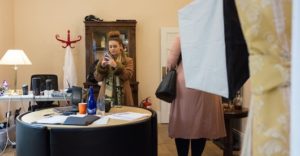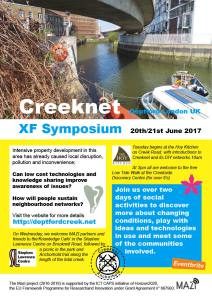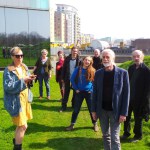Our friend Mattr performed in the Archspace in London. Jack Chutter wrote the following review in the ATTN:Magazine:
When I initially heard about live-coding, I was quick to presume that it was beyond my technical grasp. After all, surely this music was the reserve of those who have spent their lives immersed in programming, hidden behind a wall of education and natural computer aptitude, forbidden to the layman – me, for example – who should probably stick to more tangible forms of instrumental causality (hitting a drum, pressing a key). Yet coupled with my recent interview with Belisha Beacon (who went from code novice to Algorave performer within a matter of months), my experience tonight has convinced me otherwise. That’s not to say that Algorave doesn’t regularly slip beyond my technical comprehension, folding code over itself to produce spasmodic, biomechanical bursts of light and sound, ruptured by compounded multiplications and tangled up in polymetric criss-cross. Yet with the code projected upon a large screen in front of me, I see that these transparent mechanics are often painfully easy to understand. A line of code is activated: a sample starts. An empty space is deleted: a rhythmic pattern shifts one step. I witness the preparation and execution of “sudden” bass drops; I am exposed to the application of effects and shifts in pitch. At some points at least, I totally get this.
Each set is accompanied by digital projections, most of which are live-coded by the evening’s two visual artists (Hellocatfood and Rumblesan). As I walk into Archspace, the screen is brimming with these vibrant, hyperventilating spheres, all spinning at incredible speed, expanding and contracting as though set to burst. Meanwhile, the electronic pulses of Mathr feel way overcharged, bloating beyond their own mathematical confines, bleating like the alarms that herald the opening and closing of space shuttle doors or slurred bursts of laser beam. A rhythm is present but it never walks in a straight line. It’s constantly correcting itself incorrectly, sliding and slanting between shapes that never properly fit, modulating between various flavours of imbalance.
The sounds remain very much askew for Calum Gunn, although now it’s like someone playing a breakbeat remix of a Slayer track on a scratched disc, choking on the same split-second of powerchord as the beat rolls and glitches beneath, quickly abandoning all sense of rightful rhythmic orientation. Later it’s all synth hand-claps and digital squelches, exploded into tiny fragments that whoosh dangerously close to my ears. On screen, a square cascades like a spread deck of cards, fanning outward across future and past iterations, losing outline and angle in the overlap of shifted self. Together, sound and image shed all time-space integrity, knotted and crushed by the layers of multiplication and if-then function, complicating their own evolution until they can’t possibly find its way back again.
It’s almost as though Martin Klang has witnessed this chaos and taken heed. His music is carefully and precariously built, stacked in a brittle tower of drones and ticks and pops. Hi-hats spill out like coins on a kitchen floor (whoops – not quite careful enough), as the beat tip-toes between them in a nervous waltz, accompanied by what sounds like the glugging, croaking proclamations of an emptying kitchen sink. All adjustments are patiently negotiated. The soundscape switches from a duet between drone sweeps and popping fuses, to an ensemble of water-drenched bouncy balls of various sizes. I feel tense as I watch this music unfold, as though Klang’s synth might explode with just one heavy-handed application of change.
This threat doesn’t lift as we move into Miri Kat’s thick, disaster prone dub, although her sound is fearless and indifferent to it: rhythms forward-roll into mists of radiation, smacking into hydraulic doors and tangling itself in the zaps of crossed electronic wires. The rhythm comes and goes in huge obelisks of volume and visceral bass frequency, announcing themselves with thundering severity and then dropping out, allowing myth and ambient chimes to pool in the stretches of absence. At its loudest her performance is incredibly visceral, the beats wracked with the noises of ripping open, or tectonic electronic rumbling, or up-ended boxes of micro-sampled ticks and trinkets. Meanwhile, the visuals come in a gush of glitch-ruptured Playstation animation and over-zealous zoom lens, plunging into pixelated colours and flicker and burst into the far corners.
Archspace is packed out by now. Contrary to my silly assumptions that Algoraves would be an elitist, ultimately cerebral affair, a vast majority of the crowd are dancing (in fact, it is me – pinned against the side wall with my head in my notebook – who could be most readily accused of forgoing visceral enjoyment in favour of lofty pontification). This interface between code and human rhythm is further explored by Canute, tasking a live drummer to find a foothold within an ever-modulating algorithmic output, with snare drums snatching at synthesisers splayed in scattershot and krautrock 4/4s ploughing forward through a hail of ping-pong delays, while micro-samples bounce off the windscreen of those thoroughly human hits. The coded output slots into a new pacing and the drummer realigns accordingly, swerving in and around those blocks of binary exactitude, tumbling across those flatulent bursts of morse code and synthetic mandolin.
It’s a dizzy experience, and Heavy Lifting only nurtures the nausea further. Her set is like having a surreal dream while travel sick, head slumped out of the window of a gigantic cruise-liner, with the excitable voices of in-boat entertainment in one ear and the churn of the sea in the other. Spoken samples and revved motors whirl over beats that throb like an insistent headache, as samples eat themselves and fold over one another, blurred by the waves of sickness or sliced up into phonetic digital chirps. The beat throbs at ever-louder volumes. My heartbeat lodges itself in my head. Somewhere in the mixture of slur and abrasion – the precise combination of ambient wave and brash attack – Heavy Lifting strikes upon a strange form of ecstasy, as a dense rhythm rises from beneath and pushes the quease and wooze aside. It’s wonderful.
Due to a route closure and lengthy diversion affecting my journey home to Cheltenham, my own Algorave concludes tonight with a set from Belisha Beacon (my apologies to tonight’s final act, Luuma, who I had to miss as a result). Her improvisation builds itself, deconstructs itself, reshapes itself. There are no foundations, there is no final form. Raw samples (digital woodwind, dry synthetic percussion) enter one at a time and slide into place, methodically adding new angles and asymmetries to the overall shape, compounding individual decisions into a network of intersecting pulses and chimes. The 4/4 clicks into place as the rhythm shunts into a continuous stomp, finding momentary alignment before Belisha Beacon starts to pick apart the shape all over again. This methodical transparency is what sold me on the accessibility and open possibilities of live-coding. While some of tonight’s performances explore the potential of enacting numerous ideas simultaneously, splaying the code like projected firework embers, others explode the software mechanics into a series of singular steps. It’s like witnessing a film and its “making of” simultaneously, with my enjoyment of each beat enriched by the ability to share in the very spell that brought it to be.








